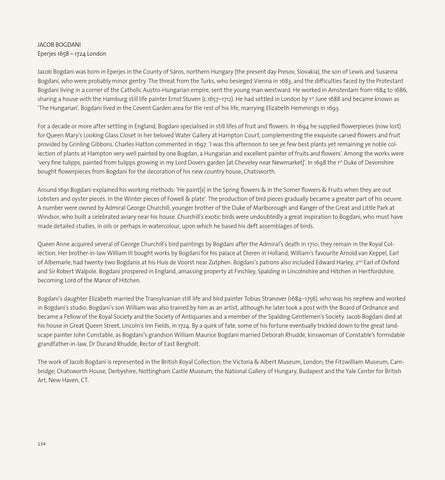JACOB BOGDANI Eperjes 1658 – 1724 London Jacob Bogdani was born in Eperjes in the County of Sáros, northern Hungary (the present day Presov, Slovakia), the son of Lewis and Susanna Bogdani, who were probably minor gentry. The threat from the Turks, who besieged Vienna in 1683, and the di≠iculties faced by the Protestant Bogdani living in a corner of the Catholic Austro-Hungarian empire, sent the young man westward. He worked in Amsterdam from 1684 to 1686, sharing a house with the Hamburg still life painter Ernst Stuven (c.1657–1712). He had settled in London by 1st June 1688 and became known as ‘The Hungarian’. Bogdani lived in the Covent Garden area for the rest of his life, marrying Elizabeth Hemmings in 1693. For a decade or more after settling in England, Bogdani specialised in still lifes of fruit and flowers. In 1694 he supplied flowerpieces (now lost) for Queen Mary’s Looking Glass Closet in her beloved Water Gallery at Hampton Court, complementing the exquisite carved flowers and fruit provided by Grinling Gibbons. Charles Hatton commented in 1697: ‘I was this afternoon to see ye few best plants yet remaining ye noble collection of plants at Hampton very well painted by one Bugdan, a Hungarian and excellent painter of fruits and flowers’. Among the works were ‘very fine tulipps, painted from tulipps growing in my Lord Dovers garden [at Cheveley near Newmarket]’. In 1698 the 1st Duke of Devonshire bought flowerpieces from Bogdani for the decoration of his new country house, Chatsworth. Around 1691 Bogdani explained his working methods: ‘He paint[s] in the Spring flowers & in the Somer flowers & Fruits when they are out Lobsters and oyster pieces. In the Winter pieces of Fowell & plate’. The production of bird pieces gradually became a greater part of his oeuvre. A number were owned by Admiral George Churchill, younger brother of the Duke of Marlborough and Ranger of the Great and Little Park at Windsor, who built a celebrated aviary near his house. Churchill’s exotic birds were undoubtedly a great inspiration to Bogdani, who must have made detailed studies, in oils or perhaps in watercolour, upon which he based his deft assemblages of birds. Queen Anne acquired several of George Churchill’s bird paintings by Bogdani after the Admiral’s death in 1710; they remain in the Royal Collection. Her brother-in-law William III bought works by Bogdani for his palace at Dieren in Holland; William’s favourite Arnold van Keppel, Earl of Albemarle, had twenty-two Bogdanis at his Huis de Voorst near Zutphen. Bogdani’s patrons also included Edward Harley, 2nd Earl of Oxford and Sir Robert Walpole. Bogdani prospered in England, amassing property at Finchley, Spalding in Lincolnshire and Hitchen in Hertfordshire, becoming Lord of the Manor of Hitchen. Bogdani’s daughter Elizabeth married the Transylvanian still life and bird painter Tobias Stranover (1684–1756), who was his nephew and worked in Bogdani’s studio. Bogdani’s son William was also trained by him as an artist, although he later took a post with the Board of Ordnance and became a Fellow of the Royal Society and the Society of Antiquaries and a member of the Spalding Gentlemen’s Society. Jacob Bogdani died at his house in Great Queen Street, Lincoln’s Inn Fields, in 1724. By a quirk of fate, some of his fortune eventually trickled down to the great landscape painter John Constable, as Bogdani’s grandson William Maurice Bogdani married Deborah Rhudde, kinswoman of Constable’s formidable grandfather-in-law, Dr Durand Rhudde, Rector of East Bergholt. The work of Jacob Bogdani is represented in the British Royal Collection; the Victoria & Albert Museum, London; the Fitzwilliam Museum, Cambridge; Chatsworth House, Derbyshire; Nottingham Castle Museum; the National Gallery of Hungary, Budapest and the Yale Center for British Art, New Haven, CT.
134
